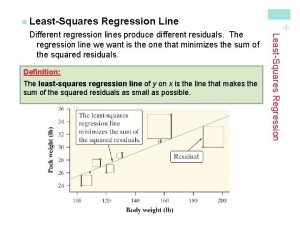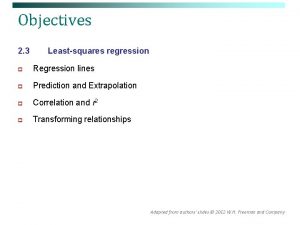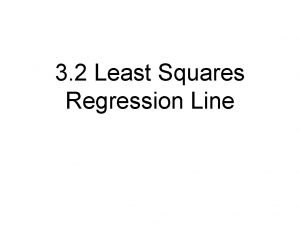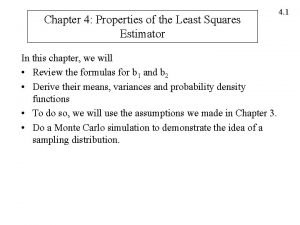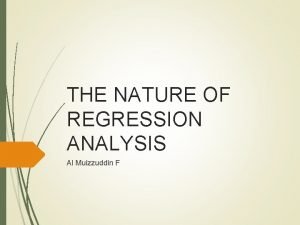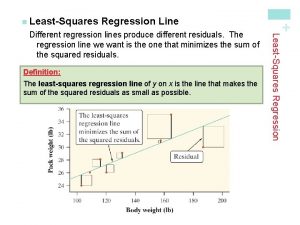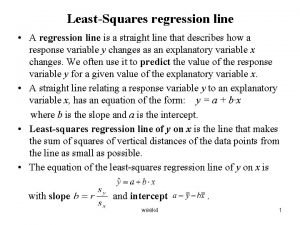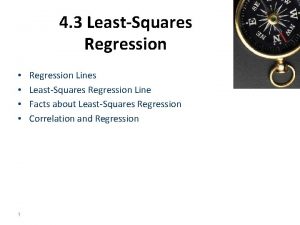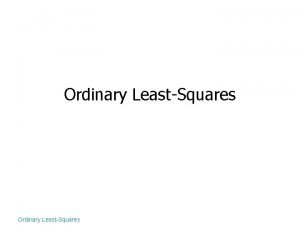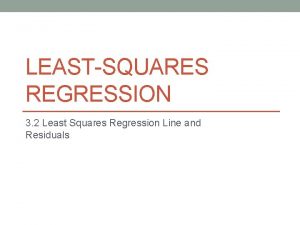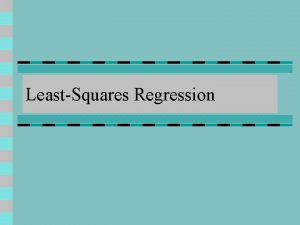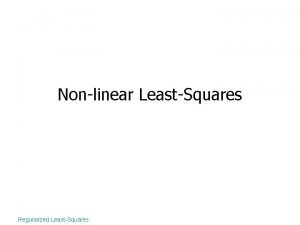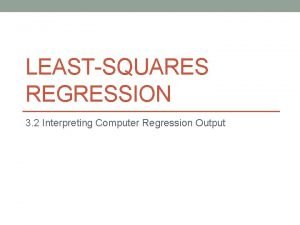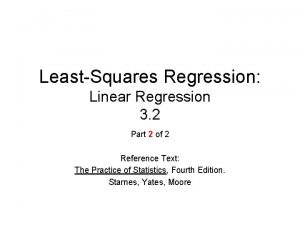LEASTSQUARES REGRESSION Section 3 3 Regression line A














- Slides: 14

LEASTSQUARES REGRESSION Section 3. 3

Regression line A straight line that describes how a response variable y changes as an explanatory variable x changes Used to predict y for a value of x

Data must have explanatory and response variables Used for linear trends

Least-squares regression line The line that makes the sum of the squares of the vertical distances of the data points from the line as small as possible y hat = a + bx where y hat is the predicted value, a is the y-intercept, and b is the slope of the line

LSRL The squares are made from the vertical distance from each point to the line.

y hat = a + bx b= r(sy/sx) The slope, b, is equal to the standard deviation of y (sy) divided by the standard deviation of x (sx) all multiplied by the correlation, r a = ybar – b*xbar The y-intercept, a, is equaly to the slope, b, multiplied by the mean for the x values, xbar, subtracted from the mean for the y values, ybar

Calculators You can calculate a, b, and r by using the Lin. Reg(a+bx) tool on your calculator Go to Stat—Calc--#8(Lin. Reg(a+bx)) There is a #4 under Calc that says Lin. Reg(ax+b), which will give you the same a and b values for the data set, but the slope is a and y-intercept is b in this function, so use #8

Coefficient of determination The fraction of the variation in the values of y that is explained by the least-squares regression of y on x r 2 Sometimes represented as a percentage % of the variation in y is explained by the least-squares regression of y on x

Facts about LSR: The distinction between explanatory and response variables is essential A change of one standard deviation in x corresponds to a change of r standard deviations in y The LSRL always passes through the point (x bar, y bar)

Residual The difference between an observed value of the response variable and the value predicted by the regression line Residual = observed y – predicted y The mean of the least-squares residuals is always zero

Residual plot A scatterplot of the regression residuals against the explanatory variable Helps assess the fit of a regression line Uniform scatter indicates the regression line fits well

Curved pattern--relationship is not linear Individual points with large residuals are outliers in the vertical (y) direction because they lie far from the line Individual points that are extreme in the x direction may not have large

Influential Observations If removing the observation would markedly change the result of the calculation, it is influential Points that are outliers in the x direction are often influential

Practice Problems pg. 176 #3. 50 -3. 61
 Classification of surveying
Classification of surveying Simple multiple linear regression
Simple multiple linear regression Multiple regression
Multiple regression Logistic regression vs linear regression
Logistic regression vs linear regression Logistic regression vs linear regression
Logistic regression vs linear regression Least squares regression line definition
Least squares regression line definition How to find least squares regression line on statcrunch
How to find least squares regression line on statcrunch Median median regression line
Median median regression line Least squares regression line
Least squares regression line Statcrunch least squares regression line
Statcrunch least squares regression line State the properties of least square estimators.
State the properties of least square estimators. Properties of regression line
Properties of regression line Least squares regression line definition
Least squares regression line definition Least squares regression line minitab
Least squares regression line minitab Ulysses poem analysis line by line
Ulysses poem analysis line by line





